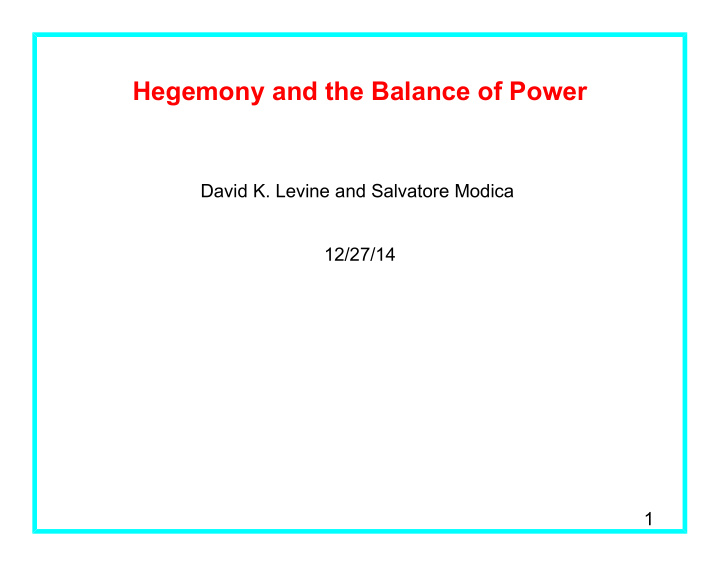



Hegemony and the Balance of Power David K. Levine and Salvatore Modica 12/27/14 1
Conflict and Institutions • there is a wide array of different institutions both across space and time • people and institutions have generally spread through invasion and conflict – Carthaginians did not emigrate to Rome • institutional change most often in the aftermath of the disruption caused by warfare and other conflicts (Bowles and some others) • which institutions are likely to be long-lived when evolution is driven by conflict and competition by groups over resources? 2
The Model • a finite collection of societies with different institutions and choices compete via conflict over a resource “land” • finitely many units of land • societies active or inactive depending on whether they have land Markovian dynamics • fast dynamic: learning – leads to global convergence to Nash • slow dynamic: conflict • strength in conflict depends on state power and amount of land • conflict resolution function – relatively standard, adjusted for several competitors – probability of losing a unit of land • land gain function – active societies more likely to get land • chances of overcoming long odds is “small” 3
The Concept of State Power • strength of institutions, mediates conflict • ability to prevail in conflict • armies, but also social infrastructure – police, judges, tax collection • soft power, bribery • ability to mobilize resources over a broad area • U.S. institutions – low taxes, high output • U.S.S.R. Institutions – high taxes, low output • both generate substantial state power 4
Applications Demography: anti-Malthus • endogenous population • output a function of population • state power is surplus of output minus subsistence • medium population maximizes state power Swords versus Jewelry • collusive state officials are residual claimants • state power needed to collect taxes • state power maximized with inefficiently “extractive” taxes 5
Key Role: Outsiders what forces are “outside”? protected by asymmetric geographical barriers – they can get at you, but you can't get at them depends on geography and technology • English channel not a barrier given English and Roman technology in Julius Caeser's time • post 1500 period naval technology and standing navies favored strongly the short coastline of England over the long coastline of continental Europe 6
Basic Results types of limit sets: • hegemony: one side gets lucky and wins • balance of power: outsiders keep switching sides • balkanization persistence and ergodic probability for small • weak outsiders – hegemony with strong state power • strong outsiders – balance-of-power with intermediate state power 7
Some Facts About Hegemony • China: 2,234 years from 221 BCE – hegemony 72% of time, five interregna • Egypt: 1,617 years from 2686 BCE - hegemony 87% of time, two interregna • Persia: 1,201 years from 550 BCE - hegemony 84% of time, two interregna • Roman Empire: 422 years from 27 BCE • Eastern Roman Empire: 429 years from 395 CE • Caliphate: 444 years from 814 CE • Ottoman Empire: 304 years from 1517 CE Remark: in 0 CE 90% of world population in Eurasia/North Africa 8
Exceptions • India • continental Europe post Roman Empire evolutionary theory: more outside influence, less hegemony • Europe: Scandinavia 5%, England 8% • India: Central Asia 5% • China: Mongolia less than 0.5% 9
Transitions: the Fall of Hegemonies two theories • cumulation of defects (Olson) • coincidence of errors (us) did the Roman empire fall because of • recession? • plague? • invasion? each unlikely and each individually recovered from but not all at once 10
Theory of Transitions • many failed revolutions/invasions • successful revolution/invasion very rapid and driven by powerful but unstable “zealots” • the model fits the details of the fall of the Ching hegemony in 1911 quite well 11
Conclusion The theory says that if we start from the observation that institutions tend to evolve through conflict between societies, rather than, say, through peaceful competition for resources, then other things should also be true passes the basic sanity test with historical data 12
Recommend
More recommend